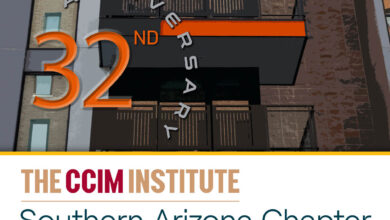
4. Space City of the Southwest
By Dave Perry
Those in the space industry have their eyes on Tucson because “we are world class,” in the words of University of Arizona College of Science Dean Carmala Garzione.
The space-slicing science begins at UArizona.
UArizona technology has allowed the James Webb Space Telescope to capture stunning, revealing images of 19 spiral galaxies similar to our Milky Way.
There’s no more powerful telescope than the Webb. For now, that is.
Early in the 2030s, on a mountain in Chile, the Giant Magellan Telescope will deploy seven 27½-foot mirrors created in the Richard F. Caris Mirror Lab beneath Arizona Stadium. It will be the most powerful telescope ever built. Nobody makes larger, more precise, more light-harvesting mirrors than UArizona.
Meanwhile, in Houston, the stubborn lid has been taken off the OSIRIS-REx canister that carried pieces of the asteroid Bennu billions of miles back to Earth. In total, the $1.2 billion UArizona-led mission returned 121.6 grams of Bennu rock and dust, twice as much as intended. Now, with extra fuel, its spacecraft is on a $200 million bonus mission, speeding to meet the stony, metallic asteroid Apophis in 2029.
In fiscal 2022, UArizona research expenditures reached $824 million. “Our goal is to get to $1 billion, which would put us in elite company” among U.S. universities, according to Elliott Cheu, UArizona interim senior VP of research and innovation, and a leader of the cutting-edge Applied Research Building.
That investment is “creating an amazing ecosystem for workforce development,” Cheu said. UArizona’s “deep involvement with the space ecosystem” launches “spinoff technologies from our faculty that end up becoming start-up companies.”
This rich academic and business environment – along with its dark, clear skies — makes Tucson incredibly attractive to space companies.
“Arizona is one of the great aerospace capitals of the world,” said Jim Cantrell, founder of Phantom Space Corporation. Phantom has recruited talent from major space players across the country. “They’ve all come to work here in Tucson, and they love it,” he said.
“It’s a great place to establish your business,” agreed Ryan Hartman, president and CEO of World View. “When you’re recruiting talent into a company … Tucson is a great aerospace city.”
“One of the smartest decisions we made was to base Paragon in Tucson,” said Grant Anderson, president and CEO of Paragon Space Development Corporation, which has been part of every human space program since 1999. “It was also the easiest decision to make.”
Paragon is creating next-generation spacesuits, and the “apartments” for people circling the Moon. Its brine-processing system is already making drinkable water for astronauts. Paragon soon will provide the high-altitude spacesuit for the first-ever stratospheric balloon jump by a woman.
In that stratosphere, at 100,000 feet, World View’s balloons allow peerless monitoring of the Earth’s surface. World View is developing its technology for space tourism, intending to take guests to six wondrous global spots such as the Grand Canyon or the Great Barrier Reef … then transport them to the space above.
Phantom “wants to be the Henry Ford of space,” Cantrell said, utilizing mass production to “launch vehicles and satellites, to make space more universally accessible, and also to bring the cost down and make getting things into space more rapid.”
Speaking of costs, FreeFall Aerospace is creating low-power antennas to support satellites. With technologies based on spherical geometry, “we’re uniquely positioned to disrupt the terrestrial and space antenna marketplace,” said Dan Geraci, the Tucson company’s CEO. “The timing is right.”
As self-described “mapmakers of the space age,” Tucson-based Lunasonde has launched its own satellite, Picacho, to test its proprietary, low-frequency antenna. With it, Lunasonde expects to discover subsurface data about Earth from orbit, looking beneath the Earth’s surface for cobalt, lithium and nickel, oil and gas, and water.
Don’t forget about Raytheon, an RTX company and the region’s largest private employer. At its Tucson Space Systems Operations facility – the Space Factory – Raytheon is creating systems that take down attacking short- and medium-range ballistic missiles in space. It’s akin to shooting a bullet at a bullet, said Randy Kempton, VP of strategic engagement systems.
“We keep the world safe,” Kempton tells his children. “We defend democracy.”
“Space is a key part of our aerospace and defense cluster, which is one of our four targeted industries for business attraction and expansion here in Southern Arizona,” said Joe Snell, president and CEO of Sun Corridor, Inc. “Anchored by the strengths of the UA, our innovations in space lead the country.”
“I would argue the breadth of our influence is unparalleled,” UArizona’s Garzione said. “We are the best.”






